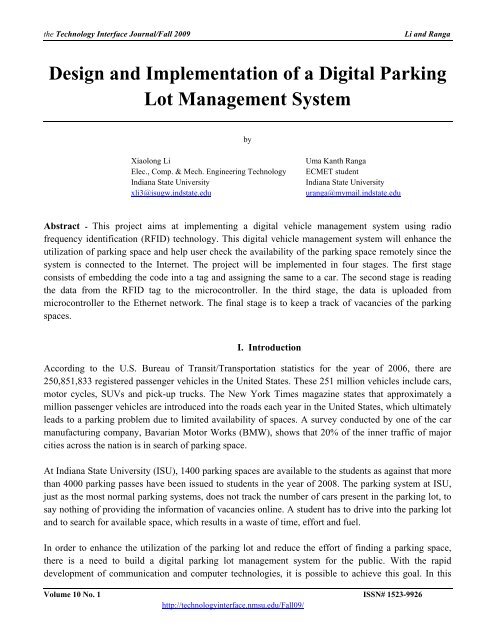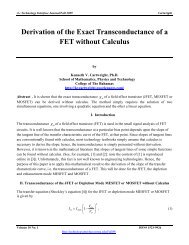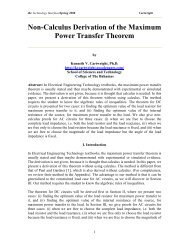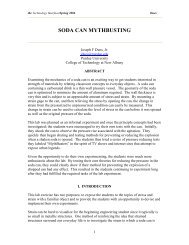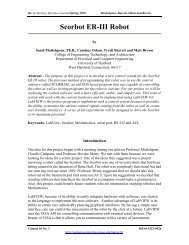Design and Implementation of a Digital Parking Lot Management ...
Design and Implementation of a Digital Parking Lot Management ...
Design and Implementation of a Digital Parking Lot Management ...
Create successful ePaper yourself
Turn your PDF publications into a flip-book with our unique Google optimized e-Paper software.
the Technology Interface Journal/Fall 2009Li <strong>and</strong> Ranga<strong>Design</strong> <strong>and</strong> <strong>Implementation</strong> <strong>of</strong> a <strong>Digital</strong> <strong>Parking</strong><strong>Lot</strong> <strong>Management</strong> SystembyXiaolong LiElec., Comp. & Mech. Engineering TechnologyIndiana State Universityxli3@isugw.indstate.eduUma Kanth RangaECMET studentIndiana State Universityuranga@mymail.indstate.eduAbstract - This project aims at implementing a digital vehicle management system using radi<strong>of</strong>requency identification (RFID) technology. This digital vehicle management system will enhance theutilization <strong>of</strong> parking space <strong>and</strong> help user check the availability <strong>of</strong> the parking space remotely since thesystem is connected to the Internet. The project will be implemented in four stages. The first stageconsists <strong>of</strong> embedding the code into a tag <strong>and</strong> assigning the same to a car. The second stage is readingthe data from the RFID tag to the microcontroller. In the third stage, the data is uploaded frommicrocontroller to the Ethernet network. The final stage is to keep a track <strong>of</strong> vacancies <strong>of</strong> the parkingspaces.I. IntroductionAccording to the U.S. Bureau <strong>of</strong> Transit/Transportation statistics for the year <strong>of</strong> 2006, there are250,851,833 registered passenger vehicles in the United States. These 251 million vehicles include cars,motor cycles, SUVs <strong>and</strong> pick-up trucks. The New York Times magazine states that approximately amillion passenger vehicles are introduced into the roads each year in the United States, which ultimatelyleads to a parking problem due to limited availability <strong>of</strong> spaces. A survey conducted by one <strong>of</strong> the carmanufacturing company, Bavarian Motor Works (BMW), shows that 20% <strong>of</strong> the inner traffic <strong>of</strong> majorcities across the nation is in search <strong>of</strong> parking space.At Indiana State University (ISU), 1400 parking spaces are available to the students as against that morethan 4000 parking passes have been issued to students in the year <strong>of</strong> 2008. The parking system at ISU,just as the most normal parking systems, does not track the number <strong>of</strong> cars present in the parking lot, tosay nothing <strong>of</strong> providing the information <strong>of</strong> vacancies online. A student has to drive into the parking lot<strong>and</strong> to search for available space, which results in a waste <strong>of</strong> time, effort <strong>and</strong> fuel.In order to enhance the utilization <strong>of</strong> the parking lot <strong>and</strong> reduce the effort <strong>of</strong> finding a parking space,there is a need to build a digital parking lot management system for the public. With the rapiddevelopment <strong>of</strong> communication <strong>and</strong> computer technologies, it is possible to achieve this goal. In thisVolume 10 No. 1 ISSN# 1523-9926http://technologyinterface.nmsu.edu/Fall09/
the Technology Interface Journal/Fall 2009Li <strong>and</strong> Rangaproject, the RFID technology has been used to maximize parking utilization. The RFID kit includesRFID windshield tags <strong>and</strong> RFID readers. The RFID reader is connected to a microcontroller in thecontrol <strong>of</strong>fice where the system is connected to the Internet. As shown in Figure 1, where a car withenabled RFID windshield tag drives up to the gate, the RFID reader will automatically read theinformation from tag through the built in antenna. The received information will be delivered to themicrocontroller where the information will be verified. If the received information matches theinformation in the database, the control <strong>of</strong>fice will send a comm<strong>and</strong> to open the barrier. The number <strong>of</strong>cars in the parking lot <strong>and</strong> the number <strong>of</strong> available spaces will be updated online immediately so thatremote user can get the correct parking information.This parking lot management system enables user to operate an unattended parking barrier withcontrolled parking access privileges. The system is ideal for apartments <strong>and</strong> condos, gated communities,business parking lots <strong>and</strong> garages, university parking areas <strong>and</strong> recreation operations from hotel to RVcamps.Figure 1: <strong>Parking</strong> lot management system [1]Volume 10 No. 1 ISSN# 1523-9926http://technologyinterface.nmsu.edu/Fall09/
the Technology Interface Journal/Fall 2009Li <strong>and</strong> RangaII. BackgroundIntroduction to RFIDRFID is a technology that incorporates the use <strong>of</strong> electromagnetic or electrostatic coupling in the radi<strong>of</strong>requency portion <strong>of</strong> the electromagnetic spectrum to uniquely identify an object, animal, or a person.The main advantage <strong>of</strong> using RFID is that it does not require direct contact or line-<strong>of</strong>-sight scanning.Figure 2 shows the basic infrastructure <strong>of</strong> an RFID system. The simplest RFID system has three majorcomponents:• An RFID tag – transponder.• An RFID reader – transceiver.• A predefined protocol for the information transferred.Figure 2: Basic infrastructure <strong>of</strong> RFID systemAn antenna is connected to the RFID reader to communicate with the transponders. It sends out theelectromagnetic field in a short range. The RFID tag is activated when it passes through a radi<strong>of</strong>requency field <strong>and</strong> sends out the programmed response. The RFID tag has a small computer chip that isprogrammed with the information that uniquely identifies the tag. The RFID tag can be passive oractive. A passive RFID tag does not contain its own power source; rather, it absorbs energy propagatedfrom a RFID reader’s antenna to supply all the power it needs to wake up its chip <strong>and</strong> communicate withthe RFID reader. Unlike passive RFID tag, an active RFID tag has built with a battery inside it toenergize the tag. Because active RFID tag uses an internal battery, its signal strength is a lot higher thanpassive tag <strong>and</strong> therefore can be read from a further distance.RFID readers are the electronic components that transmit <strong>and</strong>/or receive the RF waves used tocommunicate with the tags. The primary components <strong>of</strong> the reader are an antenna, IC board, <strong>and</strong>memory [2].The applications <strong>of</strong> RFID are ubiquitous. It can be used for inventory tracking, animal tracking,transportation payments, employee identification, newly born infant identification, <strong>and</strong> industrialVolume 10 No. 1 ISSN# 1523-9926http://technologyinterface.nmsu.edu/Fall09/
the Technology Interface Journal/Fall 2009Li <strong>and</strong> Rangaautomation <strong>and</strong> access control. RFID technology solutions are receiving much attention in the research<strong>and</strong> development <strong>of</strong> many large corporations.Introduction to MicrocontrollerMicrocontrollers are an advancement <strong>of</strong> microprocessors with memory in it. Although Intel designed8051 in the year <strong>of</strong> 1980, it is still a powerful microprocessor in today technology market. Later yearsIntel allowed other manufacturers to make <strong>and</strong> market any flavor <strong>of</strong> the 8051 they please with thecondition that they remain code-compatible with the original Intel’s 8051. Today, the market has beenlargely superseded by a vast range <strong>of</strong> faster <strong>and</strong>/or functionally enhanced 8051-compatible devicesmanufactured by more than 20 independent manufacturers [3]. The microcontroller used in this projectis Silicon lab’s C8051. C8051 is an 8-bit microcontroller with 128 bytes <strong>of</strong> RAM, 4K bytes <strong>of</strong> on-chipROM, two timers, one serial port, <strong>and</strong> four I/O ports (each 8-bits wide) [4].<strong>Design</strong> <strong>of</strong> the systemIII. <strong>Implementation</strong>The block diagram <strong>of</strong> parking lot management system is shown in Figure 3.Figure 3: Block diagram <strong>of</strong> parking lot management systemThe project is implemented in four stages:1. Writing into the tag: By making use <strong>of</strong> the write capability <strong>of</strong> the RFID reader, RFID tag isembedded with unique identification code <strong>and</strong> is assigned to a car. The tag contains distinctinformation about the car, like employee ID number or name or any other distinct data. This stepaccomplishes the data feed to the tag. This is similar to embedding information on a magneticstrip <strong>and</strong> the process is called writing.2. Reading from the tag: The information from the tag needs to be read during the car parking. Inthis step, the data is read from the tag with the help <strong>of</strong> an RFID reader.3. Data feed to the microcontroller: The data from the RFID reader has to be transferred to themicrocontroller for the actual comparison <strong>of</strong> data <strong>and</strong> further processes. During this phase the datafrom the RFID reader is fed to the microcontroller using RS232 or UART media.Volume 10 No. 1 ISSN# 1523-9926http://technologyinterface.nmsu.edu/Fall09/
the Technology Interface Journal/Fall 2009Li <strong>and</strong> Ranga4. Data transfer to Ethernet: There should be a provision for transfer <strong>of</strong> data from themicrocontroller to an Ethernet port for the purposes <strong>of</strong> displaying information for remote peopleregarding the availability <strong>of</strong> parking spaces. However, the microcontroller is not compatible withthe Ethernet in terms <strong>of</strong> transfer protocols. Thus, an AB4 Ethernet development board is neededso that the information can be properly transferred to the TCP/IP protocol.5. Tracking the count. To properly utilize the parking lot, the number <strong>of</strong> the cars presented in theparking lot needs to be tracked. This is done using the microcontroller where the number <strong>of</strong> carsin the parking lot is incremented for every car entering the lot <strong>and</strong> is decremented for every carleaving the lot.Hardware setupInstallation <strong>of</strong> RFIDThe selected Paramount’s RFID kit is a plug <strong>and</strong> play device <strong>and</strong> it has one RS-232 cable <strong>and</strong> one USBcable. The USB connection is used for powering up the RFID reader. The tags are written using MifareRead & Write s<strong>of</strong>tware tool. Figure 4 shows the Mifare Read & Write s<strong>of</strong>tware functioning.Figure 1: Mifare Read & WriteThis s<strong>of</strong>tware allows the user to write the tag information in Hexadecimal as well as in ASCII. User canselect the sector <strong>and</strong> block number where the information has to be stored in the tag. Mifare has manyfeatures which can be enabled at the time <strong>of</strong> writing like anti-collision, baud rate, beep sound on/<strong>of</strong>f.This s<strong>of</strong>tware allows the key authentication feature to detect the unauthorized tags. By making use <strong>of</strong>these functions, tags are written with ASCII A, B, C, D, E with KEY authentication as“FFFFFFFFFFFF”.Volume 10 No. 1 ISSN# 1523-9926http://technologyinterface.nmsu.edu/Fall09/
the Technology Interface Journal/Fall 2009Li <strong>and</strong> RangaInstallation <strong>of</strong> Microcontroller <strong>and</strong> Ethernet Development BoardThe following instructions illustrate how to setup the microcontroller <strong>and</strong> Ethernet development board.Figure 5 shows the connection <strong>of</strong> microcontroller development board <strong>and</strong> Ethernet development board.1. Connect the AB4 Ethernet Development Board to the C8051F120 Microcontroller target board atJ24. Apply slight pressure to ensure the mating 96-pin connectors are firmly connected.2. By making use <strong>of</strong> ribbon cable connect the USB debug adapter to the C8051F120 target board atthe JTAG header.3. Connect the one end <strong>of</strong> the USB cable to the available USB port <strong>of</strong> the PC. Connect the otherend <strong>of</strong> the USB cable into the USB connector <strong>of</strong> the debug adapter.4. Connect the AC/DC adapter to the C8051F120 target board at P1. This connection should powerboth the boards. Power is indicated by “PWR”.Figure 25: Embedded Ethernet Development board attachmentNetwork setupThe Embedded Ethernet Development Kit can be connected to the Ethernet network using a st<strong>and</strong>ardEthernet cable or directly to a PC using a crossover cable. Figure 6 shows the Embedded Ethernetconnection using a st<strong>and</strong>ard cable.As the Figure 6 shows the AB4 Ethernet Development Board is connected to an Ethernet wall outlet orto a router/switch using a st<strong>and</strong>ard Ethernet cable. A PC is also connected to the same Ethernet networkusing a st<strong>and</strong>ard Ethernet cable.For a PC to recognize an embedded system on a network, its IP address <strong>and</strong> subnet mask need to beconfigured. Below are a few guidelines for choosing an IP address for the embedded system.1. Find the IP address <strong>and</strong> Subnet mask for the PC. If a default gateway is specified, then savethis address for later use.Volume 10 No. 1 ISSN# 1523-9926http://technologyinterface.nmsu.edu/Fall09/
the Technology Interface Journal/Fall 2009Li <strong>and</strong> Ranga2. The IP address chosen for the embedded system must match the PC’s IP address in all bitlocations where the Subnet mask is 1 in order for the PC to recognize the embedded system.Otherwise, the PC will send its request outside <strong>of</strong> the local network.3. Do not duplicate IP addresses or select a broadcast address. An IP address is considered as abroadcast address if all bits which are 0 in the Subnet mask are 1 in the IP address.4. The address 255.255.255.255 is known as the Ethernet broadcast address <strong>and</strong> is used whenthe Subnet mask for the network is not known. Any packet transmitted to this address willreach all nodes on the local network but cannot go further than the nearest router.Building the projectConnect the system as shown in Figure 7. Once the IP address for AB4 Ethernet development board hasbeen set, the microcontroller is ready for the programming. The following is the explanation <strong>of</strong> majorfunctions for this project.Figure 6: Embedded Ethernet Network Connection (St<strong>and</strong>ard Cable)The main function <strong>of</strong> the main.c is to load the webpage for digital parking system. Three moreprogramming codes have been used for the functioning <strong>of</strong> the system. MN_callback.c is used forupdating the webpage content. Serial.c program is used for sending comm<strong>and</strong>s to the RFID reader. Themain.c will call the serial.c function throughout the working <strong>of</strong> the system. For the RFID reader to workproperly, the manufacturers’ protocols has to be followed. The smartcard.c is used to set the features likeanti-collision, select <strong>and</strong> load keyset, <strong>and</strong> authentication. Serial.c function will call the smartcard.cprogram to ensure that the authentic smart card is read. Whenever a car enters into a parking lot, thereader will detect the RFID tag in the car, <strong>and</strong> the smartcard.c program will make sure the card havebeen issued earlier by checking the authentication key <strong>and</strong> ASCII code.Volume 10 No. 1 ISSN# 1523-9926http://technologyinterface.nmsu.edu/Fall09/
the Technology Interface Journal/Fall 2009Li <strong>and</strong> RangaFigure 7: System connectionsUpdating the file arrays using CMX HTML2CA web server content is added to the project in the form <strong>of</strong> file arrays because the cross compiler used bythe microcontroller can only underst<strong>and</strong> C- language <strong>and</strong> Hex code. The HTML2C utility reads any file(HTML, images, executable binary files, etc.) <strong>and</strong> generates two files naming original_filename.h <strong>and</strong>original_filename.c that can be added to the project. Once the index.html is dragged <strong>and</strong> dropped intothe HTML2C conversion space, it will create index.c <strong>and</strong> index.h which are used in the digital parkingsystem execution.Execution <strong>and</strong> viewing the resultAfter including the HTML code in the main program, the system has to be compiled once again formaking sure that it has zero errors. Once the program code is compiled with zero errors, the embeddedsystem can be removed from the PC. Now the flash memory is loaded with digital parking system code<strong>and</strong> ready to function. In this process the embedded system <strong>and</strong> RFID system were connected in Master-Slave configuration. The advantage in making the embedded server as a master is that themicrocontroller functions with clock period. Microcontroller will prompt the RFID for every 13 msec. Ifthe reader scans any tag in that time, it will send a response to microcontroller along with the scanneddata. The web page will be downloaded as shown in Figure 8.Volume 10 No. 1 ISSN# 1523-9926http://technologyinterface.nmsu.edu/Fall09/
the Technology Interface Journal/Fall 2009Li <strong>and</strong> RangaFigure 38: Web page for digital parking systemAll the car parking slots are initially empty. Whenever a car enters into a parking lot, one slot will beturned into car symbol, showing the parking lot user arrives. Figure 9 shows digital parking systemwhen filled with one car.Figure 9: <strong>Digital</strong> parking system output when filled with one carVolume 10 No. 1 ISSN# 1523-9926http://technologyinterface.nmsu.edu/Fall09/
the Technology Interface Journal/Fall 2009Li <strong>and</strong> RangaIV. ConclusionsBy making use <strong>of</strong> the Paramount’s RFID kit <strong>and</strong> Silicon labs’ C8051F120 microcontroller <strong>and</strong> AB4Ethernet development board, a digital parking lot management system was designed <strong>and</strong> implemented inthis project. With this digital parking system, a car with authorized RFID tag can fast enter the parkinglot without manually scanning the parking permit. This parking system will also help users view theavailability <strong>of</strong> the parking space remotely. Therefore, this system helped user reduce the wasting time <strong>of</strong>search parking lot <strong>and</strong> also improve the parking lot utilization.References[1]. GAO RFID Inc., “RFID Enabled Automated <strong>Parking</strong> Access Control Systems”, Retrieved May 5 th ,2009 http://parking.gaorfid.com/[2] Banks, J., Hanny, D., Pachano, M. A., <strong>and</strong> Thompson, L. G. RFID Applied. John Wiley <strong>and</strong> Sons,2007.[3] Mazidi, M. A., <strong>and</strong> Mazidi, J. G., The 8051 Microcontroller <strong>and</strong> Embedded Systems. PearsonEducation, 2006[4] Silicon Laboratories. (2008). “Embedded Ethernet Development Kit's User Guide”. RetrievedOctober 15, 2008 https://www.silabs.com/Support%20Documents/TechnicalDocs/Ethernet-DK.pdfDr. XIAOLONG LI received his bachelor <strong>and</strong> master degrees in electrical <strong>and</strong> information engineeringdepartment at the Huazhong University <strong>of</strong> Science <strong>and</strong> Technology, Wuhan, China, in 1999 <strong>and</strong> 2002,Volume 10 No. 1 ISSN# 1523-9926http://technologyinterface.nmsu.edu/Fall09/
the Technology Interface Journal/Fall 2009Li <strong>and</strong> Rangarespectively. He received his Ph.D. degree in electrical <strong>and</strong> computer engineering department at theUniversity <strong>of</strong> Cincinnati in 2006. He joined the Morehead State University in 2006, where he was anassistant pr<strong>of</strong>essor in the department <strong>of</strong> Industrial <strong>and</strong> Engineering Technology. In 2008, he joined thedepartment <strong>of</strong> Electronics, Computer <strong>and</strong> Mechanical Engineering Technology at the Indiana StateUniversity, where he is currently an assistant pr<strong>of</strong>essor. Dr. Li teaches courses <strong>of</strong> computerprogramming, computer electronics, computer networking, etc. His current research interest is in theareas <strong>of</strong> wireless <strong>and</strong> mobile networking <strong>and</strong> microcontroller-based applications.Mr. Uma Kanth Ranga is a master student in the department <strong>of</strong> Electronics, Computer <strong>and</strong> MechanicalEngineering Technology at the Indiana State University. His major research interest is in the area <strong>of</strong>microcontroller-based applications.Volume 10 No. 1 ISSN# 1523-9926http://technologyinterface.nmsu.edu/Fall09/


